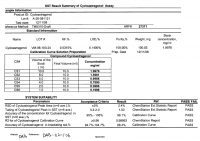At this point in time, I do believe we are the only company that guarantees cycloastragenol in our product to the public, is there anyone else?
You may not be selling Astragalus, but If you state that all astragalus extracts have cycloastragenol, then you need to state how much. However it appears that by your own post you believe that Cycloastragenol does not naturally exist in astragalus and can only be produced as an acid-base byproduct of Astragoloside IV.
From your earlier post:
Cycloastragenol is extracted from astragalus membranaceus, and is as far as I know it is the acid-base byproduct of Astragoloside IV.
I don't understand how you can try to argue both things in your posts ("naturally found in all astragalus" vs "It is not natural found, but an acid based byproduct of Astragaloside IV").
As far as my burden, it is to simply guarantee our own products. If you want to make regular Astragalus comparisons against our product, then it is your burden to state how much cycloastragenol is found in the regular astragalus product you want people to consider, instead of arguing things that apparently you are not sure about.
A
Anthony I'm not sure if you're kidding around, because otherwise I don't know how much more clear I can be about the fact that the statement I took issue with was this one:
3- Yes Smithx is right, we are the only company that offers cycloastragenol to the public.
That is a lie.
With regard to whether cycloastragenol is a metabolite of Astragalus Membranaceus, or directly found in the raw :
1) It doesn't matter unless you're injecting it
2) Yes I wasn't sure at the time, and it isn't information that I need to provide to you. You should know everything there is to know about Astragalus, since Astragalus Radiix extract is essentially what you're selling. It's pretty bothersome that you have close to no knowledge about it's composition. How can you be selling cycloastragenol and not know where it comes from? Moreover, how can you possibly claim that you are the only company offering it, when you clearly don't know that it is a naturally occurring glycoside?
3) After a little digging, I confirmed that it does in fact occur directly in Astragalus Membranaceus, and about 10 other species of Astragalus, and not as a metabolite, at least not only as a metabolite.
http://www.sciencedi...20&searchtype=aAbstract
Agroastragaloside II, a new astragaloside was isolated from the hairy root culture of Astragalus membranaceus. its structure was established as 3-O-β-(2′-O-acetyl)-d-xylopyranosyl-6-O-β-d-glucopyranosyl-(24S)3β,6α,16β,24,25-pentahydroxy-9,19-cyclolanostane on the basis of spectroscopic data. Three known astragalosides, astragaloside II, isoastragaloside I and 3-O-β-d-xylopyranosyl-cycloastragenol were also isolated.
To access the rest of these links you need an account at sciencedirect (otherwise just abstract), but I'll post them up in case you do. They are far too long to post in entirety, and I'm not going to spend my time creating an out of context chop, but suffice to say it is present. Of course you can take this information and run a red herring on it, pointing out that the links only demonstrate effects of the total fraction, but the instant retort is that you have far less evidence for activity on your side. Also, I made, and make no claims about the effectiveness of your product, just that it is not the only one that contains cycloastrageonl, and that Astraglus Radiix extract/raw herb, which IS present on the market, is not only biologically active, but active against the target (telomeres) your company markets.
http://www.sciencedi...34&searchtype=ahttp://www.sciencedi...fb&searchtype=ahttp://www.sciencedi...d4&searchtype=a3.3. Natural compounds
3.3.1. The Chinese herb Astragalus
Astragalus has been used in traditional Chinese medicine for thousands of years, often in combination with other herbs, to boost the immune system. It contains antioxidants which protect cells against damage caused by free radicals. Astragalus is also reputed to have antibacterial, anti-inflammatory, and diuretic properties, and the plant is sometimes used topically for wounds. However, little was known about the mechanism of action of Astragalus until recent studies revealed that its downstream targets include telomeres and their maintenance (Fauce et al., 2008). TAT2 the drug extract from the Astragalus root, Astragalus membranaceus(Huang Qi) exerts its effect on telomerase. Exposure of CD8+ T cells from HIV-infected human donors to TAT2 inhibited telomere shortening, increased the proliferative potential of the cells, and, importantly, enhanced cytokine/chemokine production and antiviral activity (Fauce et al., 2008). The telomerase-dependent specificity of TAT2 is demonstrated by an effect of telomerase inhibitor, suggesting that TAT2 operates to raise immunity by enhancing telomerase maintenance of telomeres (Fauce et al., 2008).
Telomere maintenance is required for all immune cells undergoing clonal expansion; however, HIV infection causes exhaustion of CD8+ T cell proliferation and shortening of telomeres (Wolthers et al., 1996). It is accepted that HIV infection interferes with telomere maintenance in CD8+ cells and increases senescence in both CD8+ and CD4+ T cells ([Aladdin et al., 2000], [Bestilny et al., 2000], [Nichols et al., 1999] and [Palmer et al., 1997]). Telomere maintenance is also affected in CD4+ T cells, with decreased hTERT expression and hTERT protein phosphorylation (Franzese et al., 2007). People who live with HIV infection for many years without developing AIDS showed high telomerase activity and longer telomeres in T cells than patients who progressed to AIDS (Tucker et al., 2000). Constitutive over-expression of hTERT leads to increased maintenance of previous telomere by telomerase in CD8+ T cells, which contributes to maintenance of polyfunctional HIV-1-specific CD8+ T cells from HIV-1 controllers ([Dagarag et al., 2004] and [Lichterfeld et al., 2008]). These studies suggest that telomere maintenance by telomerase, which is preserved in vitro by the Chinese herb Astragalus, is critical to the correct functioning of lymphocytes.
Again, these are just example articles to support my claim that Astragalus extract/raw herb is active, and that it contains cycloastragenol, and are in no way comprehensive. I feel that if you're selling the stuff, you should be interested enough to do your own research. The burden to prove the greater, or even equal effectiveness of your product compared to other Astragalus products, specifically with regard to the relevance of the "formulation" you settled on, is yours, as you are the entity attempting to profit from this information.
The ginseng example was just that, an example. In my experience isolated herbal fractions do not have the same qualitative effect that the whole parent does. Empiric evidence shows this to hold true for Gotu Kola, Turmeric, and Ginseng, and I merely suggested that this may hold true for Astragalus, as the vast majority of studies on this substance, demonstrating positive effect, have been from the natural extract or whole herb, and as far as I'm aware not a single study beyond a cell culture for any particular fraction. However, that really isn't the point, I was just disputing the idea that you somehow own the cycloastragenol market. That is a wacky idea, since it's extracted from Astragalus.
I'm not arguing that you guarantee a certain amount of it, no one ever made that statement. This is something that should be self evident: either it's on the label or it isn't. I wasn't challenging the "uniqueness" of the mixture either; or the fact that you guarantee it on the label, or why 150mg is somehow an ideal amount, the latter for which I suppose there is no answer, and not something I want to get into, and not what I have been posting about.
If your next reply is going to be a terse quip to an out-of-context quote, save yourself the time, I don't care, and won't be following the thread any longer. The purpose was to make sure you were being straight with your potential customers, and if what you wrote, what I quoted above was a slip up, it should be trivial to admit, and not worth these confrontational, and frankly somewhat embarrassing squabbles.































 This topic is locked
This topic is locked























